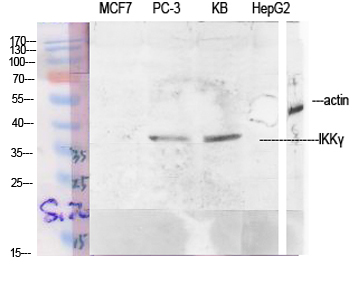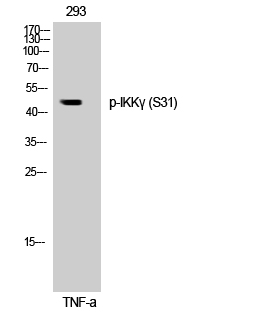Phospho IKK-γ (S31) Cell-Based Colorimetric ELISA Kit
- 货号:KA1260C
- 应用:ELISA
- 种属:Human
- 其他名称:
- NF-kappa-B essential modulator (NEMO) (FIP-3) (IkB kinase-associated protein 1) (IKKAP1) (Inhibitor of nuclear factor kappa-B kinase subunit gamma) (I-kappa-B kinase subunit gamma) (IKK-gamma) (IKKG) (IkB kinase subunit gamma) (NF-kappa-B essential modifier)
- 背景:
- caution:The sequence shown here is derived from an Ensembl automatic analysis pipeline and should be considered as preliminary data.,disease:Defects in IKBKG are a cause of immunodeficiency without anhidrotic ectodermal dysplasia [MIM:300584]; also called isolated immunodeficiency or pure immunodeficiency. Patients manifest immunodeficiency not associated with other abnormalities, and resulting in increased infection susceptibility. Patients suffer from multiple episodes of infectious diseases.,disease:Defects in IKBKG are the cause of ectodermal dysplasia anhidrotic with immunodeficiency X-linked (EDAXID) [MIM:300291]; also known as hypohidrotic ectodermal dysplasia with immunodeficiency (HED-ID). Ectodermal dysplasia defines a heterogeneous group of disorders due to abnormal development of two or more ectodermal structures. EDAXID is characterized by absence of sweat glands, sparse scalp hair, rare conical teeth and immunological abnormalities resulting in severe infectious diseases.,disease:Defects in IKBKG are the cause of ectodermal dysplasia anhidrotic with immunodeficiency-osteopetrosis-lymphedema (OLEDAID) [MIM:300301].,disease:Defects in IKBKG are the cause of incontinentia pigmenti (IP) [MIM:308300]; formerly designed familial incontinentia pigmenti type II (IP2). IP is a genodermatosis usually prenatally lethal in males. In affected females, it causes abnormalities of the skin, hair, eyes, nails, teeth, skeleton, heart, and central nervous system. The prominent skin signs occur in four classic cutaneous stages: perinatal inflammatory vesicles, verrucous patches, a distinctive pattern of hyperpigmentation and dermal scarring.,disease:Defects in IKBKG are the cause of recurrent isolated invasive pneumococcal disease type 2 (IPD2) [MIM:300640]. Recurrent invasive pneumococcal disease (IPD) is defined as two episodes of IPD occurring at least 1 month apart, whether caused by the same or different serotypes or strains. Recurrent IPD occurs in at least 2% of patients in most series, making IPD the most important known risk factor for subsequent IPD.,disease:Defects in IKBKG are the cause of susceptibility to X-linked familial atypical micobacteriosis type 1 (AMCBX1) [MIM:300636]; also known as X-linked disseminated atypical mycobacterial infection type 1 or X-linked susceptibility to mycobacterial disease type 1. AMCBX1 is the X-linked recessive form of mendelian susceptibility to mycobacterial disease (MSMD). MSMD is a congenital syndrome resulting in predisposition to clinical disease caused by weakly virulent mycobacterial species, such as bacillus Calmette-Guerin vaccines and non-tuberculous, environmental mycobacteria. Patients are also susceptible to the more virulent species Mycobacterium tuberculosis.,function:Regulatory subunit of the IKK core complex which phosphorylates inhibitors of NF-kappa-B thus leading to the dissociation of the inhibitor/NF-kappa-B complex and ultimately the degradation of the inhibitor. Also considered to be a mediator for TAX activation of NF-kappa-B. Could be implicated in NF-kappa-B-mediated protection from cytokine toxicity.,online information:IKBKG mutation db,PTM:Mono-ubiquitinated on Lys-277 and Lys-309; promotes nuclear export.,PTM:Phosphorylation at Ser-68 attenuates aminoterminal homodimerization.,PTM:Polyubiquitinated on Lys-285 through 'Lys-63'; the ubiquitination is mediated by NOD2 and RIPK2 and probably plays a role in signaling by facilitating interactions with ubiquitin domain-containing proteins and activates the NF-kappa-B pathway.,PTM:Polyubiquitinated on Lys-399 through 'Lys-63'; the ubiquitination is mediated by BCL10, MALT1 and TRAF6 and probably plays a role in signaling by facilitating interactions with ubiquitin domain-containing proteins and activates the NF-kappa-B pathway.,PTM:Sumoylated on Lys-277 and Lys-309 by SUMO1; the modification results in phosphorylation of Ser-85 by ATM leading to a replacement of the sumoylation by mono-ubiquitination on these residues.,similarity:Contains 1 C2HC-type zinc finger.,subunit:Homodimer; disulfide-linked. Component of the I-kappa-B-kinase (IKK) core complex consisting of CHUK, IKBKB and IKBKG; probably four alpha/CHUK-beta/IKBKB dimers are associated with four gamma/IKBKG subunits. The IKK core complex seems to associate with regulatory or adapter proteins to form a IKK-signalosome holo-complex. Part of a complex composed of NCOA2, NCOA3, CHUK/IKKA, IKBKB, IKBKG and CREBBP. Interacts with COPS3, CYLD, NALP2, TRPC4AP and LRDD. Interacts with ATM; the complex is exported from the nucleus. Interacts with TRAF6. Interacts with HTLV-1 Tax oncoprotein; the interaction activates IKBKG. Interacts with TANK; the interaction is enhanced by IKBKE and TBK1. Part of a ternary complex consisting of TANK, IKBKB and IKBKG.,tissue specificity:Heart, brain, placenta, lung, liver, skeletal muscle, kidney and pancreas.,
- 功能:
- leukocyte homeostasis, B cell homeostasis, activation of immune response, lymphocyte homeostasis, immune response-activating cell surface receptor signaling pathway, positive regulation of immune system process, immune response-activating signal transduction, immune response-regulating signal transduction, immune response-regulating cell surface receptor signaling pathway, transcription, induction of apoptosis, immune response, cell surface receptor linked signal transduction, intracellular signaling cascade, protein kinase cascade, I-kappaB kinase/NF-kappaB cascade, activation of NF-kappaB-inducing kinase activity, regulation of cell death, positive regulation of cell death, induction of programmed cell death, regulation of phosphate metabolic process, activation of protein kinase activity, positive regulation of kinase activity, regulation of phosphorylation, homeostatic process, regul
- 细胞定位:
- Cytoplasm . Nucleus . Sumoylated NEMO accumulates in the nucleus in response to genotoxic stress. .
- 组织表达:
- Heart, brain, placenta, lung, liver, skeletal muscle, kidney and pancreas.


